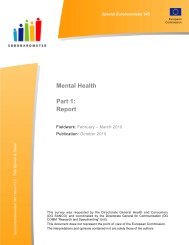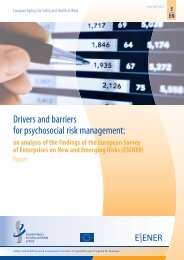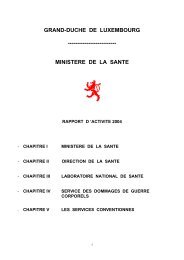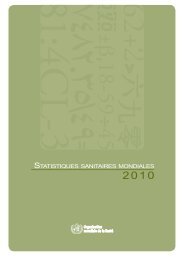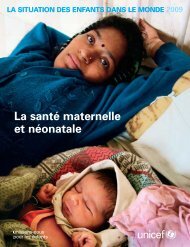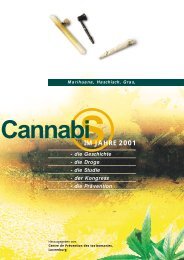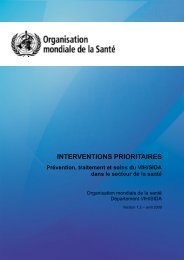Global Tuberculosis Control 2010 - Florida Department of Health
Global Tuberculosis Control 2010 - Florida Department of Health
Global Tuberculosis Control 2010 - Florida Department of Health
Create successful ePaper yourself
Turn your PDF publications into a flip-book with our unique Google optimized e-Paper software.
First, the variance for the distribution was taken as:<br />
V = ((u – l)/4) 2<br />
where l and u are the lower and upper bounds <strong>of</strong> the plausible<br />
range for the CDR.<br />
Shape 1 (noted α) and shape 2 (noted β) follow from:<br />
s =<br />
E(l – E)<br />
– l<br />
V<br />
α = sE<br />
β = s(l – E)<br />
where E is the expected value <strong>of</strong> the distribution.<br />
Time series for the period 1990–2009 were built according<br />
to the characteristics <strong>of</strong> the three CDRs that were<br />
estimated. A cubic spline extrapolation <strong>of</strong> V and E, with<br />
knots set at the three reference years, was used. Incidence<br />
trajectories were derived from the series <strong>of</strong> notified<br />
TB cases using Monte Carlo simulations from which<br />
expected values, 2.5th and 97.5th centiles were extracted.<br />
All computations were conducted in the R statistical<br />
environment. 1<br />
If there were insufficient data to determine the factors<br />
leading to time-changes in case notifications, incidence<br />
was assumed to follow a horizontal trend going through<br />
the most recent estimate <strong>of</strong> incidence.<br />
<br />
<br />
<br />
For high-income countries, the level <strong>of</strong> TB incidence was<br />
assumed to be distributed between the notification rate<br />
for new and relapse cases combined (lower uncertainty<br />
bound, noted l) and 1.3 times the notification rate (upper<br />
uncertainty bound, noted u), as informed by expert opinion.<br />
The distribution <strong>of</strong> incidence was assumed to follow<br />
a Beta distribution with shape parameters computed<br />
using the method <strong>of</strong> moments, as described above.<br />
In the absence <strong>of</strong> country-specific data on the quality<br />
and coverage <strong>of</strong> TB surveillance systems, it was assumed<br />
that TB surveillance systems from countries in the highincome<br />
group performed similarly well, although the<br />
model does allow for stochastic fluctuations.<br />
<br />
<br />
Incidence can be estimated using measurements from<br />
national surveys <strong>of</strong> the prevalence <strong>of</strong> TB disease combined<br />
with estimates <strong>of</strong> the duration <strong>of</strong> disease. Incidence<br />
is estimated as the prevalence <strong>of</strong> TB divided by the<br />
average duration <strong>of</strong> disease.<br />
The duration <strong>of</strong> disease cannot be directly measured.<br />
For example, measurements <strong>of</strong> the duration <strong>of</strong> symptoms<br />
in prevalent TB cases that are detected during a preva-<br />
1<br />
R Development Core Team. R: a language and environment for statistical<br />
computing. Vienna, R Foundation for Statistical Computing, ,<br />
2009 (ISBN 3-900051-07-0; http://www.R-project.org).<br />
lence survey are systematically biased towards lower<br />
values, since active case-finding truncates the natural<br />
history <strong>of</strong> undiagnosed disease. Measurements <strong>of</strong> the<br />
duration <strong>of</strong> disease in notified cases ignore the duration<br />
<strong>of</strong> disease among non-notified and untreated cases.<br />
Literature reviews commissioned by the WHO <strong>Global</strong><br />
Task Force on TB Impact Measurement have provided<br />
estimates <strong>of</strong> the duration <strong>of</strong> disease in untreated TB<br />
cases from the pre-chemotherapy era (before the 1950s).<br />
The best estimate <strong>of</strong> the mean duration <strong>of</strong> disease (for<br />
smear-positive cases and smear-negative cases combined)<br />
in HIV-negative individuals is about three years.<br />
There are few data on the duration <strong>of</strong> disease in HIVpositive<br />
individuals.<br />
When measurements from two prevalence surveys<br />
were available, trends in TB incidence were derived by<br />
fitting a log-linear model to indirect estimates <strong>of</strong> TB<br />
incidence. When three or more prevalence measurements<br />
were available, the prevalence trajectory was built<br />
using cubic spline interpolation. If only one prevalence<br />
survey measurement was available, time-trends were<br />
assessed using in-depth analysis <strong>of</strong> surveillance data, as<br />
described above.<br />
In this report, the prevalence to incidence method<br />
was used for only one country (Viet Nam), following a<br />
meeting in early 2009 in which consensus was reached<br />
among national experts and experts from WHO and the<br />
KNCV <strong>Tuberculosis</strong> Foundation.<br />
<br />
<br />
In three countries (Brazil, Mexico and South Africa),<br />
incidence was estimated from 1990 up to 2008 from TB<br />
mortality data, using the following equation:<br />
incidence =<br />
deaths<br />
proportion <strong>of</strong> incident cases that die<br />
Previously published time-series <strong>of</strong> incidence for those<br />
three countries were then extended to 2009, using methods<br />
described in .<br />
<br />
<br />
In all remaining countries, previously published timeseries<br />
<strong>of</strong> TB incidence were extended by fitting a log-linear<br />
model to the estimates for 2006–2008, to predict a<br />
value for 2009.<br />
<br />
<br />
<br />
All the annual reports on global TB control published by<br />
WHO from 1997 to 2009 included estimates <strong>of</strong> the incidence<br />
<strong>of</strong> sputum smear-positive TB and the related CDR<br />
for such cases. The CDR for sputum smear-positive pulmonary<br />
TB is the number <strong>of</strong> new and relapse cases <strong>of</strong> sputum<br />
smear-positive pulmonary TB notified to NTPs divided by



